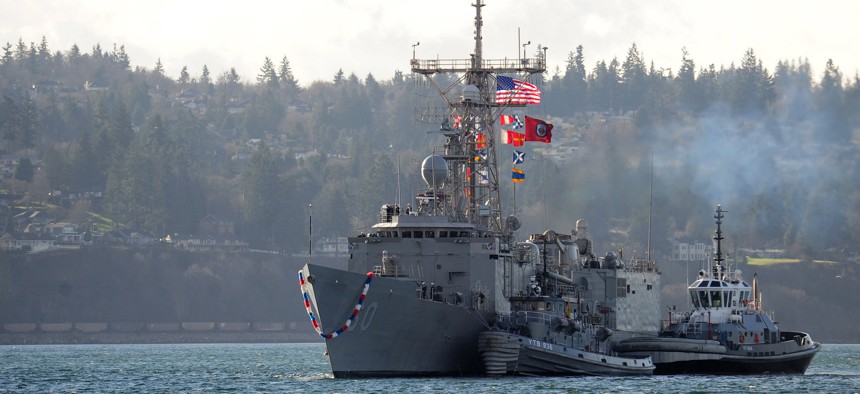
The Oliver Hazard Perry-class frigate USS Rodney M. Davis (FFG 60) returns to homeport at Washington state's Naval Station Everett, Dec. 19, 2014, ahead of decommissioning in 2015. U.S. Navy photo by Mass Communication Specialist 2nd Class Jeffry A. Willadsen
The US Navy's Next Frigate Should Jumpstart a Revitalization of the Defense Industrial Base
As it searches for a good design at a good price, the Pentagon should bear in mind decades-old lessons about manufacturing's ties to national security.
The United States Navy requires a frigate. Building this warship will strengthen our depleted naval fleet and reenergize a vital sector of the nation’s defense industrial base, especially in the Midwest “rust-belt” region of the nation.
In July, the Navy issued a request for information to shipbuilding manufacturers for a new frigate. Officials said they want a “mature design” — in other words, a proven ship. The service will even consider a foreign warship, so long as it is built in the United States by Americans. The United States has not been a global leader in shipbuilding for a generation. The new frigate program is an opportunity to bring new designs, new construction techniques, lower prices, and higher efficiency back to the U.S. shipbuilding industry. The frigate program also gives the Pentagon and contractors an opportunity to take a wider strategic look at the nation’s defense industrial base.
Such a strategic look at America’s defense industrial base was last performed by the Eisenhower Administration. Under Project Solarium, small teams of experts examined strategies for confronting the Soviet Union, and made specific and detailed recommendations for investing in the defense industrial base. A key component of their findings was that the nation must establish critical redundancies within a dispersed defense industrial base to ensure that the nation could continue to defend itself in the event of a massive Soviet attack.
America’s investment in its defense industrial base, as envisioned by Solarium, stood the nation in good stead until the end of the Cold War. With the fall of the Berlin Wall and the election of Bill Clinton, America sought a “peace dividend.” In turn, there were massive cuts to the defense budget and the nation’s defense contractors quickly consolidated to a handful of mega-companies. The impact on downstream armament component suppliers has been even more profound. For some key components, the nation’s aircraft, ship, and tank manufacturers have only one domestic supplier. For others, our manufacturers depend completely on foreign suppliers.
America has also seen a devaluation of blue-collar manufacturing jobs over the past generation. Educational institutions and society at large emphasized the importance of liberal arts college degrees as the path to success, leaving the nation short of citizens with the technical and vocational skills that are critical to manufacturing ships, aircraft and armor. Our weapons makers are constantly short of welding, pipefitting, electrical, heating and air conditioning, and industrial painting workers, even though these jobs pay well and often come with union pensions. It is a truism that for every position in a Great Lakes shipyard, there are four to six additional jobs in downstream sub-component manufacturers throughout the region. Indeed, defense industry leaders say the lack of skilled workers is one of the reasons that it is very difficult to rapidly increase production.
The Navy’s new frigate program would provide an incentive for major and subcontractors to invest in training the next generation of skilled manufacturing workers. The current plan is to build 20 frigates. In reality, the Navy requires 35 to 50 of them. Moreover, such a warship could be pitched to allies and partners in Europe, the Middle East and Asia who are confronting a resurgent Russia, expansionist Iran, and assertive China.
While we believe that the Navy should select the best combatant warship at the best price, the Pentagon should keep in mind the recommendations made over half a century ago by the Solarium teams: redundancy and manufacturing dispersal make America safer. Taking such matters into consideration might run somewhat counter to a generation of management and efficiency theory that thrives on just-in-time delivery and low-bid contracts. But with strategists now talking about the unthinkable — great-power conflict with Russia or China — the Pentagon and defense industry leaders must once again focus on the survivability of our defense industrial base. Without a safe, distributed defense industrial base, there are no new ships, aircraft or tanks for our military in a conflict.
As recent accidents and peacetime fatalities have demonstrated, the current 280-ship Navy is broken. President Trump promised the nation a 350-ship fleet and the new frigate program will go a long way towards getting us there. The frigate program can also serve as the catalyst to rebuilding America’s defense industrial base. And that, in turn, will mean thousands of high-paying manufacturing jobs for American workers and a safer country.